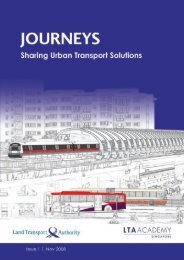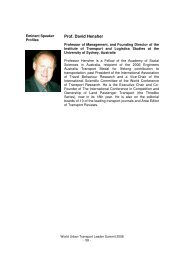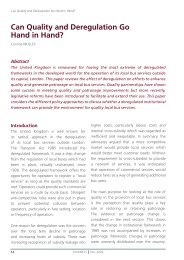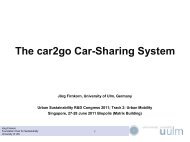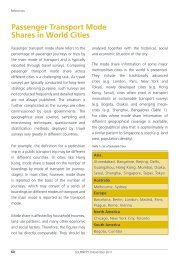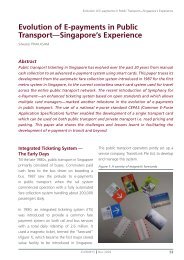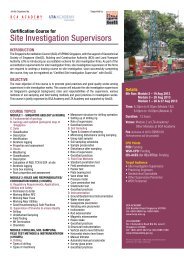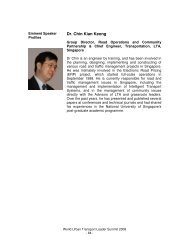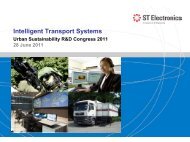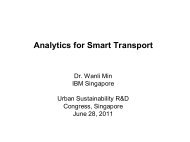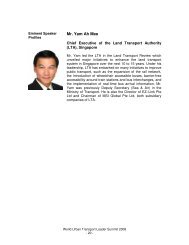Full Version - Issue 7 | November 2011 - LTA Academy
Full Version - Issue 7 | November 2011 - LTA Academy
Full Version - Issue 7 | November 2011 - LTA Academy
You also want an ePaper? Increase the reach of your titles
YUMPU automatically turns print PDFs into web optimized ePapers that Google loves.
Freight Tax Incentives in Japan<br />
In Japan, three types of taxes are imposed on<br />
freight vehicles:<br />
(i) A one-time vehicle acquisition tax<br />
(ii) An annual vehicle tonnage tax (based on<br />
weight)<br />
a vehicle’s operational efficiency through<br />
such measures as reducing speeding,<br />
minimising gear changing, and scheduling<br />
regular inspections. As a complementary<br />
measure, economies are urged to<br />
implement programmes aimed at raising<br />
the awareness of freight companies and<br />
drivers about the link between fuel-efficient<br />
driving practices and safe operations, as<br />
well as, the fact that saving 10 percent on<br />
fuel costs can increase a freight company’s<br />
bottom line by 15-35 percent.<br />
...economies are urged to implement<br />
programmes aimed at raising the<br />
awareness of freight companies and<br />
drivers about the link between fuelefficient<br />
driving practices and safe<br />
operations, as well as, the fact that<br />
saving 10 percent on fuel costs can<br />
increase a freight company’s bottom<br />
line by 15-35 percent.<br />
Policies to Encourage Transport<br />
System Efficiency<br />
• Reducing Road Congestion<br />
To mitigate road congestion, the workshop<br />
recommendations include implementing<br />
demand-centric measures to reduce<br />
Recommendations for Improving Transportation Energy Efficiency in APEC Economies<br />
(iii) An annual vehicle capacity tax (based on<br />
cargo capacity)<br />
To incentivise fuel efficient freight vehicles,<br />
Japan reduces the level of all three taxes for<br />
fuel-efficient vehicles.<br />
JOURNEYS | <strong>November</strong> <strong>2011</strong><br />
congestion on existing roads, before<br />
implementing supply-centric measures (e.g.,<br />
building more roads), since experience has<br />
shown that the addition of more roads does<br />
not alleviate congestion. Another strategy<br />
is to price parking in commercial business<br />
districts at a rate that prevents congestion<br />
due to “parking cruisers”. Studies have<br />
shown that the ideal price for parking may<br />
be one that ensures a 15 percent vacancy<br />
rate at any given time, so that vehicles<br />
looking for parking will not contribute to<br />
congestion and emissions by circling city<br />
blocks.<br />
...Studies have shown that the<br />
ideal price for parking may be one<br />
that ensures a 15 percent vacancy<br />
rate at any given time, so that<br />
vehicles looking for parking will<br />
not contribute to congestion and<br />
emissions by circling city blocks.<br />
Congestion pricing systems can also be<br />
extremely effective, particularly when<br />
they are designed to maximise congestion<br />
reduction rather than revenue generation.<br />
Charging for congestion rather than, or<br />
in addition to, car ownership enables<br />
policy to shape marginal behaviour,<br />
47



